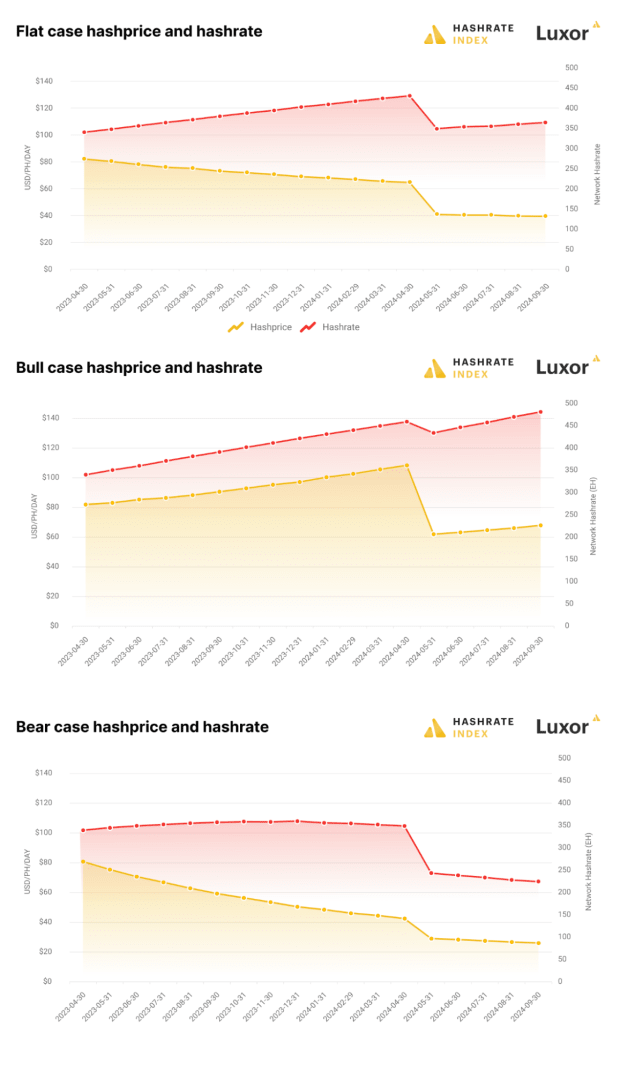Since Bitcoin’s inception, community problem has grown from 1 to as a lot as 48.71 trillion hashes {that a} miner would theoretically have to generate to seek out the successful one. This implies it’s 48.71 trillion occasions more durable to mine a Bitcoin block in the present day than when mining first started in 2009 — a compound improve of 20.64% per thirty days.
On the time of this writing, Bitcoin’s problem is at an all-time excessive, which implies that miners — on a BTC foundation — are making much less in rewards per unit of hash fee than ever earlier than. Subsequent to bitcoin’s value, Bitcoin’s problem is a main issue that influences hash value (mining income per unit of hash fee), so miners are all for projecting Bitcoin’s hash fee progress and problem tendencies for enterprise planning.
To this finish, miners and Bitcoiners devised the constant-block-time methodology for estimating upcoming changes, however this methodology sometimes over or underneath estimates problem modifications in the beginning of every problem epoch.

To enhance on this, the group at Luxor Applied sciences developed a brand new methodology known as the “rolling-block methodology,” which we describe in additional element in a latest report on forecasting Bitcoin mining problem.
It’s our hope that the rolling-block methodology for forecasting Bitcoin problem might present miners, traders and hash fee merchants a greater instrument to plan for problem modifications
Luxor’s ‘Rolling Block Methodology’ For Forecasting Problem Changes
For this report, we developed a brand new time sequence forecasting methodology for upcoming problem changes, which improves accuracy in the beginning of the epoch in comparison with the fixed block time methodology. We name this the succinctly-named “rolling-2,015-block, square-root-weighted, epoch-adjusted block time methodology” (or simply “rolling-block methodology,” “adjusted-block-time methodology,” or “dual-epoch methodology”).
This new methodology improves upon the constant-block-time methodology early within the epoch by together with block occasions from the earlier 2,015 blocks, as an alternative of simply the blocks from the present epoch, which may skew forecasts early within the epoch for lack of knowledge factors. To account for the change in community problem between epochs, block occasions within the earlier epoch are adjusted by the earlier adjustment. And eventually, we weight the common block occasions of the present epoch with the sq. of the proportion by way of the epoch. This last step is to decrease the impression of block occasions from the earlier epoch as the present epoch progresses since these values don’t truly decide the upcoming adjustment.
Within the chart beneath, we are able to see by way of confidence intervals that the brand new methodology carried out higher than the previous mannequin in the beginning of the epoch as much as block 650, but it surely carried out barely extra poorly thereafter:

This forecast, in fact, is just for projecting the subsequent problem adjustment. What if we wished to forecast, say, a yr into the long run?
Lengthy-Time period Bitcoin Mining Problem Forecasting
Luxor has developed fashions for long-term problem forecasting, as properly, however these fashions are clearly rather more complicated, since they span an extended timeframe.
Our mannequin takes the bitcoin value, transaction charges and block subsidy as inputs on the demand facet, and inner knowledge on ASIC manufacturing estimates and working price distributions throughout the trade on the provision facet. Utilizing these inputs, the mannequin produces an equilibrium hash fee, problem and hash value for 18-month durations.
The mannequin construction displays actuality; hash fee, problem and hash value are endogenous to the system, not exogenous determinants of each other. We are able to conduct sensitivity analyses with the mannequin throughout all inputs as properly. For instance, we are able to forecast an equilibrium hash fee, problem, and hash value throughout a spread of bitcoin costs.
The charts beneath current projections from our up to date hash fee provide and demand mannequin. It gives estimates for flat, bull and bear bitcoin value eventualities.

Hash Charge, Problem And Hash Worth Projection Updates
Hash fee is an rising asset class and digital commodity market. Hash fee market members like Bitcoin miners, hosters, lenders, traders and merchants want entry to the rigorous financial evaluation and knowledge obtainable in different commodity markets.
Luxor will likely be dedicated to offering this evaluation and forecasting on a quarterly foundation. In the event you’d wish to be taught extra, please go to this submit.
This can be a visitor submit by Colin Harper. Opinions expressed are fully their very own and don’t essentially replicate these of BTC Inc or Bitcoin Journal.
from Bitcoin – My Blog https://ift.tt/x7lSonR
via IFTTT

No comments:
Post a Comment